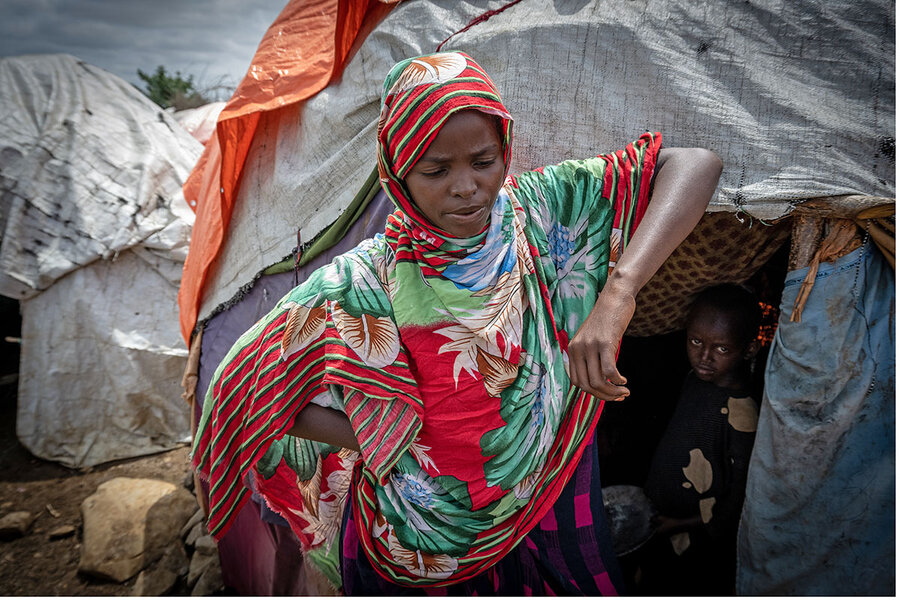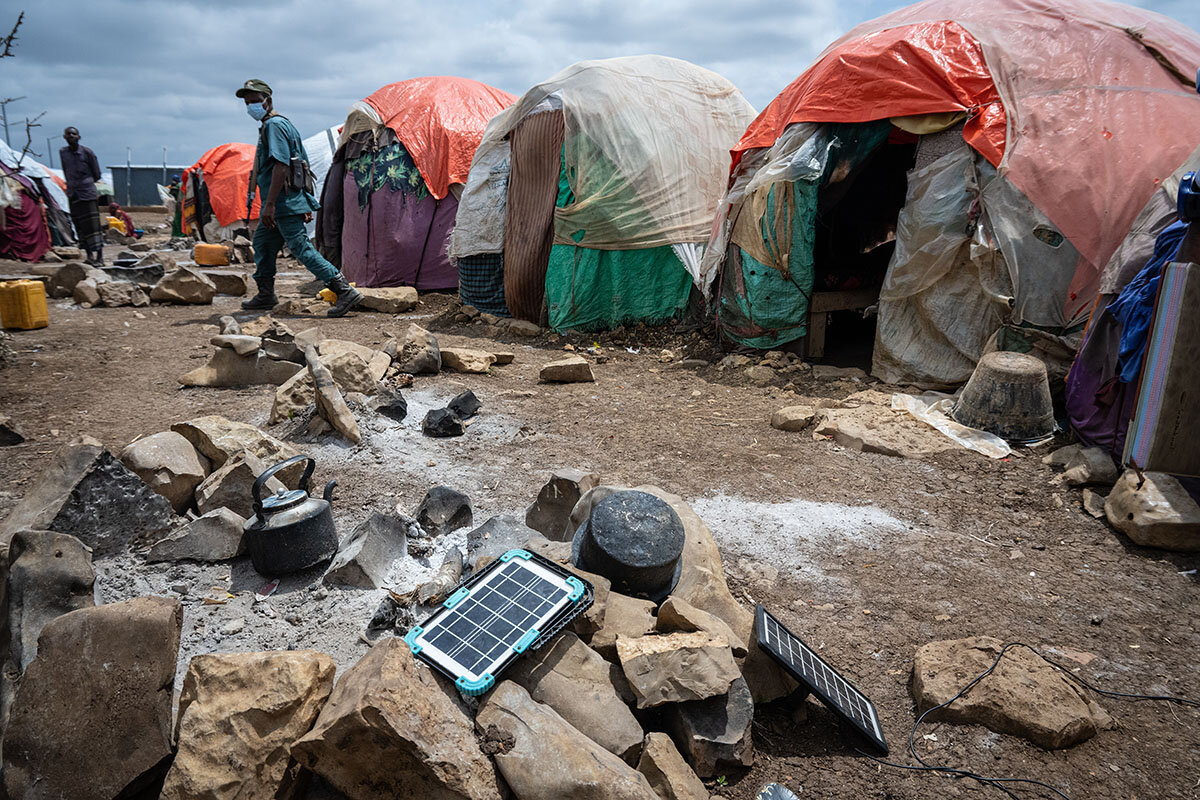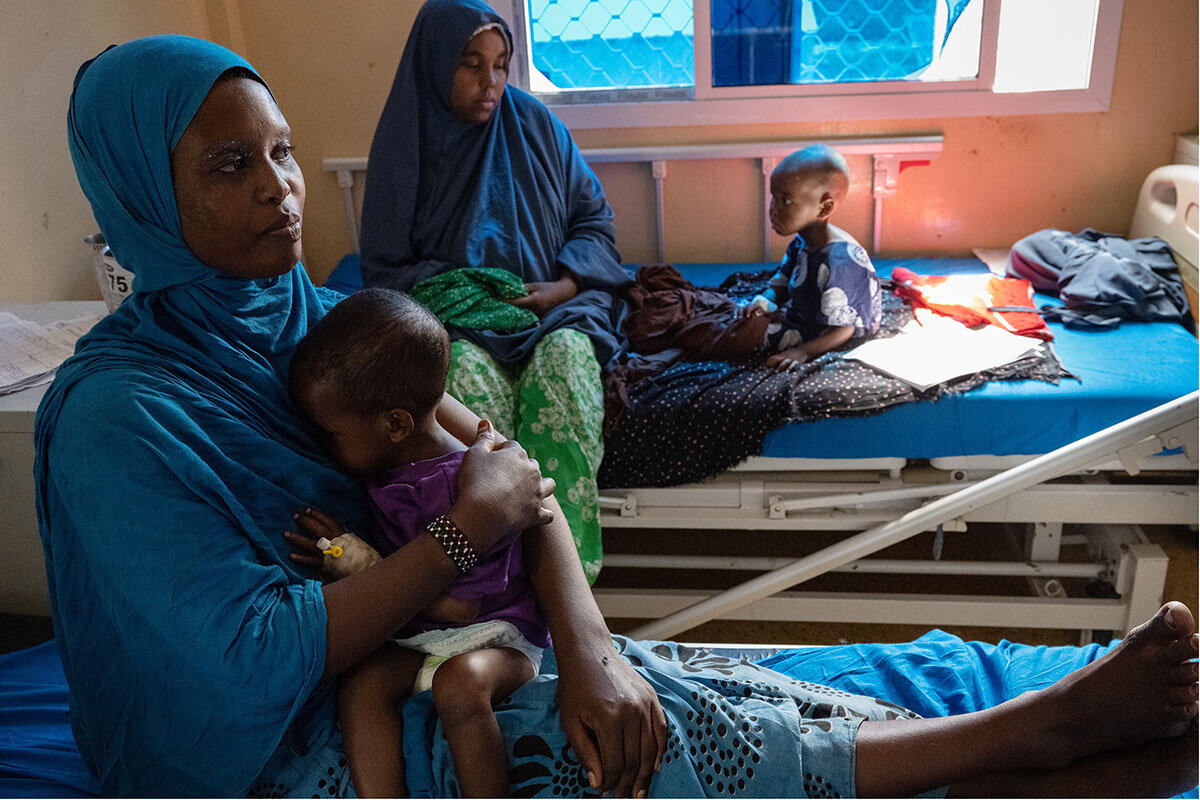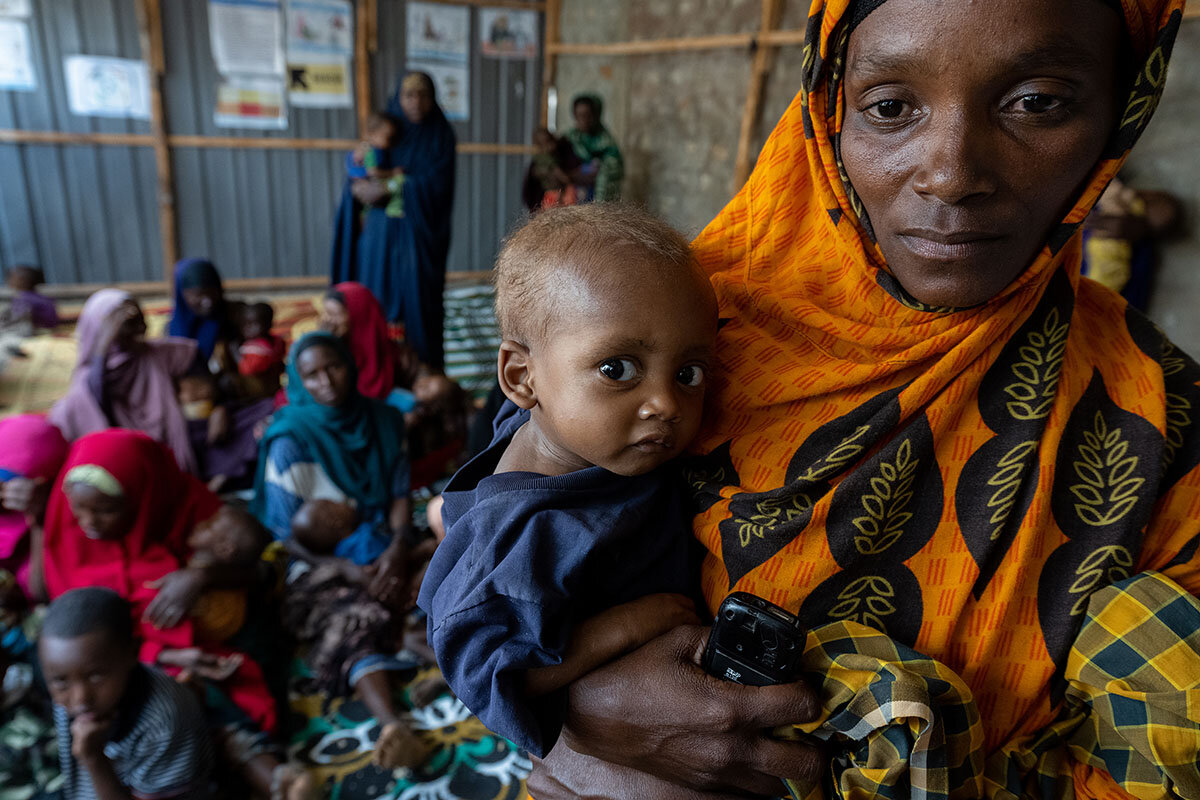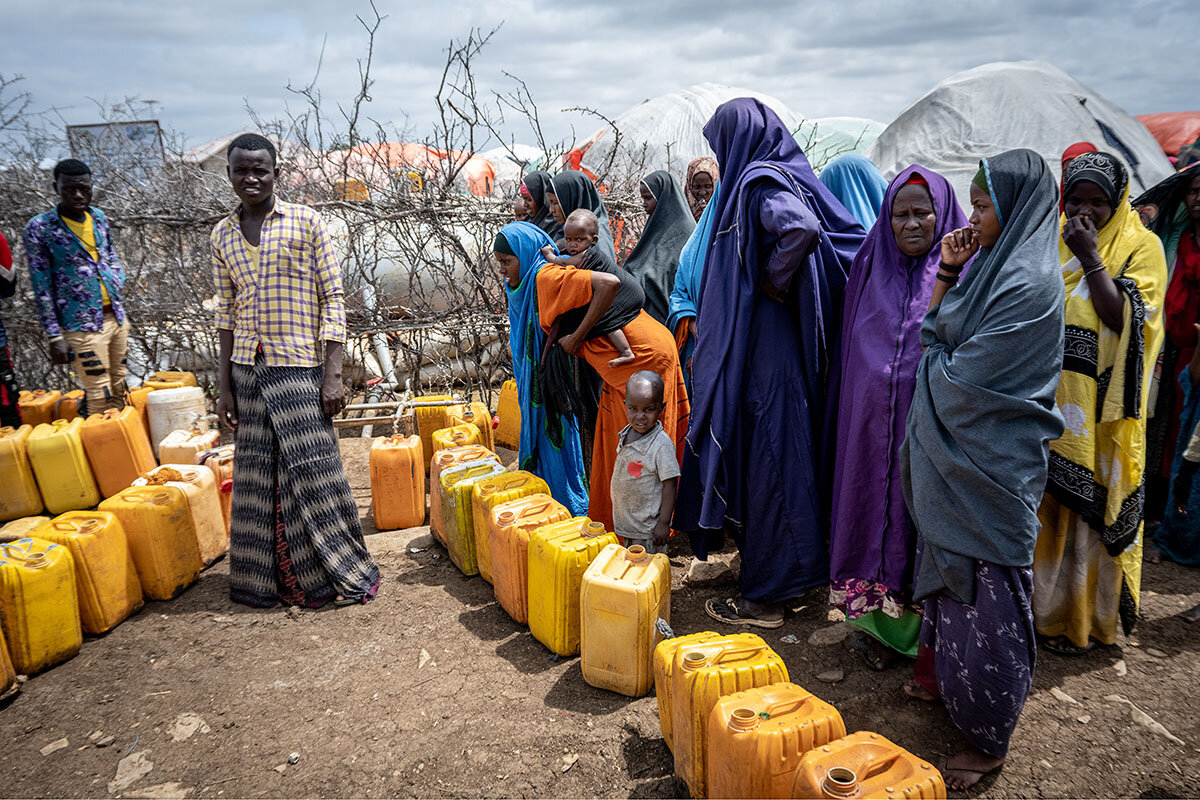Somalia on brink of famine. Can new tools, timely aid avert the worst?
Loading...
| BAIDOA, Somalia
Standing amid a sprawling camp of makeshift tents, Suado Hassan Abdi, a Somali mother with five young children, can’t even calculate the scale of her family’s losses.
The worst drought to strike Somalia in 40 years – marked by four failed rainy seasons in a row, with a fifth likely to come – desiccated the crops she had planted with her husband, leaving no food or fodder.
At the door of her tent, Ms. Abdi struggles to take stock, days after arriving in this congested camp on the outskirts of Baidoa, the drought-stricken epicenter of a nation stalked by famine.
Why We Wrote This
A story focused onSomalia’s worst drought in 40 years has sparked warnings from the U.N. of unprecedented catastrophe. This time, though, a functioning government is coordinating among aid agencies. Still needed: generosity.
Three of her children hover listlessly beside their new abode: mud-smeared layers of tarps pulled across a small frame of tree branches.
How many camels, cows, and goats did they lose?
“Uncountable,” replies Ms. Abdi, looking down. “They died.”
The unfolding tragedy that triggered this family’s decision to move, to escape the clutches of drought and conflict, echoes widely among the hundreds of thousands of newly destitute Somalis who, forced to abandon their pastoralist lifestyle in search of water and food, surge to cities like Baidoa.
The displaced families are the sharp end of a burgeoning humanitarian catastrophe in Somalia that the United Nations and international aid agencies warn may become unprecedented in both scale and lethality – with 1.5 million children alone at risk of acute malnutrition – unless there is a further infusion of lifesaving aid and compassion.
Government-controlled Baidoa is surrounded on all sides by Islamist Al Shabaab militants and can only be supplied by air.
Ms. Abdi’s children have survived, and now play with scoops of dirt on tin plates in this bleak camp. But not every Somali family here can say the same. Many children were buried during the journey, others after funerals in the hundreds of camps that ring Baidoa.
Today in Baidoa’s main hospital, cases of acute malnutrition among the smallest children – each one usually comforted by an anxious mother as they undergo emergency feeding – attest to Somalia’s hard-fought battle to keep famine at bay.
Somali officials and foreign aid workers alike say the country remains at the tipping point, and that the response in coming weeks will determine whether another devastating famine is notched in Somalia’s modern history, or whether it will show that the worst was largely averted.
“We are knocking on the door of famine right now,” says Abdirahman Abdishakur Warsame, the president’s envoy for drought response, in an interview in Mogadishu. “If we don’t get the right, timely response, timely humanitarian assistance, we are facing a catastrophe of famine.”
He weaves into his plea a theme being heard with more urgency in the developing world, that poorer societies are bearing the brunt of climate-related calamities made worse by decades of carbon emissions from wealthy, industrialized nations.
“It’s a shame for the international community. ... Nobody should die from hunger, especially children,” Mr. Warsame says. “That’s why I am saying, ‘Help us. This is a moral obligation. This is what you have caused.’”
Scope of the challenge
Half of Somalia’s population of 15.7 million is affected by the drought and facing “acute food shortages,” with 1.1 million displaced by both drought and conflict, according to U.N. figures. Across the Horn of Africa, a chronic shortfall of rain that is attributed to climate change is affecting 36 million people.
But there are key differences between today’s crisis and the droughts of decades past that could help limit the human toll: Well-honed data collection mechanisms are available to better forecast and pinpoint needs, and government structures now exist to share the burden and help coordinate priorities.
The government of President Hassan Sheikh Mohamud, which has only been in office since May, inherited a crisis management system broken by years of official neglect, political deadlock, and the COVID-19 pandemic. Though it has not yet declared a famine – focusing instead on a new offensive against Al Shabaab – the government is credited with a serious effort to facilitate a humanitarian response that will keep more Somalis alive.
“We’re still teetering on the brink; the mortality rates are increasing in some areas,” says a U.N. humanitarian official in Mogadishu who asked not to be further identified. Still, urgent appeals are starting to be heard, with a significantly scaled-up response and a 300% increase in the amount of assistance reaching Somalis.
With European Union and British donor funds having shrunk due to the Ukraine war, the United States – which traditionally has funded 50% to 55% of Somalia’s food needs – is now funding 70% of that assistance. The U.S. has nearly doubled its funding, from $460 million in 2021 to $888 million in 2022.
Even if food targets are reached, however, other areas critical to fending off famine such as improving poor sanitation, hygiene, and access to clean water are getting less attention and cash.
“What’s driving the high malnutrition rates is not the lack of food. It’s cholera; it’s poor sanitation,” says the U.N. official. “So to prevent the increasing rates of malnutrition, there needs to be a real investment in those core sectors ... to then prevent people getting to the need for nutrition assistance. So until that happens, there is a vicious cycle.”
That grim dynamic is clear at Mogadishu’s Banadir Hospital for mothers and children, where the severest malnutrition cases are those recovering from measles.
“Somehow they will survive; it depends on their condition – some arrive with shock,” says Dr. Mohamed Yassin Hirey. The numbers of those hospitalized have “increased significantly” in the past four months, he says, with more than 20 new patients being admitted each day.
Surge of displaced people
The U.N. formally sounded the alarm when it published drought response plans in December 2021 and June 2022, though neither made waves as Russia’s war against Ukraine got underway.
But a “final warning to all of us” on Somalia did take hold in early September, when Martin Griffiths, the U.N.’s top humanitarian and emergency relief coordinator, said he was “shocked to my core” during a visit “by the level of pain and suffering we see so many Somalis enduring.”
He said conditions today are worse than those seen in 2010-2011, when famine in Somalia claimed some 260,000 lives. The “unprecedented” combination of dangers, he said, will last at least through March 2023. The U.N. last week issued a revised funding requirement of $2.26 billion – up 55% from previous estimates – to deliver “immediate, lifesaving assistance” into early 2023.
In Baidoa, local officials describe an exponential surge in the number of exhausted and needy arrivals at camps for displaced people in recent months, and put the total now at nearly 900,000.
Dubbed the “City of Death” for its high casualties during the 1992 famine, this dusty city is defined by inhospitable heat, patchy sharp scrub, and thorn trees that stretch to the horizon in every direction – a barren view now often populated by an ocean of domed huts.
Early November brought a taste of rain. It triggered a blush of green, which may just be enough to feed livestock, but likely not to plant crops – or end the drought.
Indeed, the deleterious effects of drought have been compounded by chronic insecurity, including Al Shabaab destroying water sources and crops. Most of those displaced in Baidoa have left areas controlled by Al Shabaab. The militants have warned them not to return.
“The state and donors are collectively working to respond to the influx ... so that is why there are less people dying,” says Baidoa Mayor Abdullahi Ali Watiin, whose city has been surrounded by Al Shabaab for 12 years.
Yet handling the current emergency is only part of the picture for Mr. Watiin, who says officials are “thinking how we can adapt to this climate change,” including finding alternatives to rain-fed farming.
Improved coordination
Coping on the drought front line are agencies like Concern Worldwide, an Irish charity that has worked in Somalia for more than 30 years, and in the camps provides everything from built latrines and clean water to hygiene kits and solar lights.
Other relief agencies fill other gaps, as identified in weekly meetings hosted by local officials.
It is a real improvement from the 2011 famine, when lack of coordination meant “some people were getting too much, and next to them people were dying,” says Ahmed Ali Issack, who heads the Concern Worldwide office in Baidoa. “Now the existence of the government structure, at district and state levels, facilitates this coordination.”
Chairing those meetings is Dini Abdinur, head of the regional Ministry of Humanitarian Affairs and Disaster Management.
“There are animal deaths, high malnutrition – some children are dying,” says Mr. Abdinur. “The government and NGOs are trying their best to minimize the death rate.”
While the new government started taking steps in late spring, more could have been done by all sides, says a second U.N. official in Mogadishu, who also requested anonymity.
“Though we probably started seeing famine-like conditions in May, we didn’t have the data for decision-makers to decide whether to act early,” the official says. “But we could have started systematically much, much earlier.”
That is not news to Asieh Hussein Buule, who cradles her 20-day-old baby daughter, Aisha Hassan Haro, while sitting on a tiny wood-frame platform that keeps the mother and her nine children a few inches off the ground in their branch-frame shelter.
The family has only the very basics in their Baidoa camp. But Ms. Buule’s gratitude – for making it this far, with all her children alive, to a place of security and survival – is clear on her face, as she affectionately holds and plays with her children.




